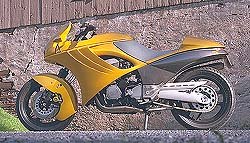MachineArt MK9 - Motorcycle.com
Aprilia, Bimota, Ducati. The mere names can send you deep into a Euro-moto fantasy of strafing apexes on a smooth asphalt ribbon twisting through the Mediterranean countryside, diving down through hillside vineyards swept with crisp autumn sunlight, colors swirling in your turbulent wake. Time for lunch, you think, and make a quick turn for your favorite bistro. Gliding in with a low rumble, black leather hugging luscious Italian bodywork, sidewalk patrons drop slow motion forkfulls of seafood crepes and portobello mushrooms on clattering plates as you approach.
"Your usual table, Signor, and the lovely lady at the corner table has sent this bottle with her compliments." Ah, "la dolce vita," you think to
Now don't get us wrong, we like Kawasakis. But unlike our opening trio of Italian supermodels, a search for high style among the Japanese Big Four will leave you hard pressed to find unique, inspired design. For example, the Suzuki GSX-R750 recently established solid leadership in sportbike value and performance, but it didn't exactly make its way to the top with irresistible beauty. Sorry GSX-R owners, but we think most people would agree that the Gixxer's visual design is no competition for the suave Ducati 916. Why is that? Maybe because the Suzuki is so much cheaper?
As proof he created the MachineArt MK9, a completely road worthy and street-legal concept bike that demonstrates what Kawasaki's competent but uninspiring GPz1100 could have been. Intrigued, we arranged to meet up with Serbinski at his home in rural New Jersey to talk about the current state of affairs in motorcycle design, and to get the first test-ride of his latest creation.
It's obvious that Serbinski is frustrated with the status quo from Japan. "Motorcycles that have lots of personality," claims Serbinski, "like Ducatis, were the vision of one or a few people rather than a committee -- which is how the Japanese ones are (typically) designed. When the Japanese do a new product, they gather competitive product pictures together and put them in a kind of a matrix of styles to evaluate. The problem is they're using existing products to capture visual information, and if they're designing something new they shouldn't base it solely on what exists now because it's already old stuff. They should be challenging existing norms and thinking of other ways to interpret what the design ought to be. (Instead) they're all watching each other very closely."
If you're wondering when the MK9 might hit your local showroom, the answer may be 'never.'
Of course, it's one thing to promise such a transformation, but quite another to actually deliver a bike that can outclass the best results of a Japanese design team. But when Serbinski rolled the MK9 out into the clear light of afternoon, all hype became reality. I wanted it immediately!
Finally it was our chance to discover first-hand what it's like to ride the MK9, which up to this point had never been pried from the designer's loving hands. Your first impression is that the MK9 feels fat in the waist, splitting your legs apart like a wishbone. Combined with a wider-than-normal turning radius, this can turn low speed maneuvering into a chore. But once underway the impression of width is completely replaced by a sense of comfort, with lots of room to move around.
I was pleased to find that the body was good for more than just first-class posing, being surprisingly effective at directing wind around the rider despite the short, rakish windscreen. We cruised on backroads at speeds up to 70 mph with little more than a breeze reaching the cockpit. With no wind tunnel testing in the picture, Serbinski admitted that he simply designed it to look good and got lucky with the aerodynamics.
That's a shame really, because we think an excellent case can be made that motorcycle design can move smartly into the future without losing its traditional appeal. As you read this, Serbinski and company are considering alternatives for bringing the MK9 style to the marketplace. And new plans are underway for the next MachineArt concept bike, this time to be based on a twin-spar frame design. Stay tuned.
MACHINEART Industrial Design66 Willow AvenueHoboken, NJ 07030201 714-9846201 714-9849 fax
More by Bob Larson

































Comments
Join the conversation